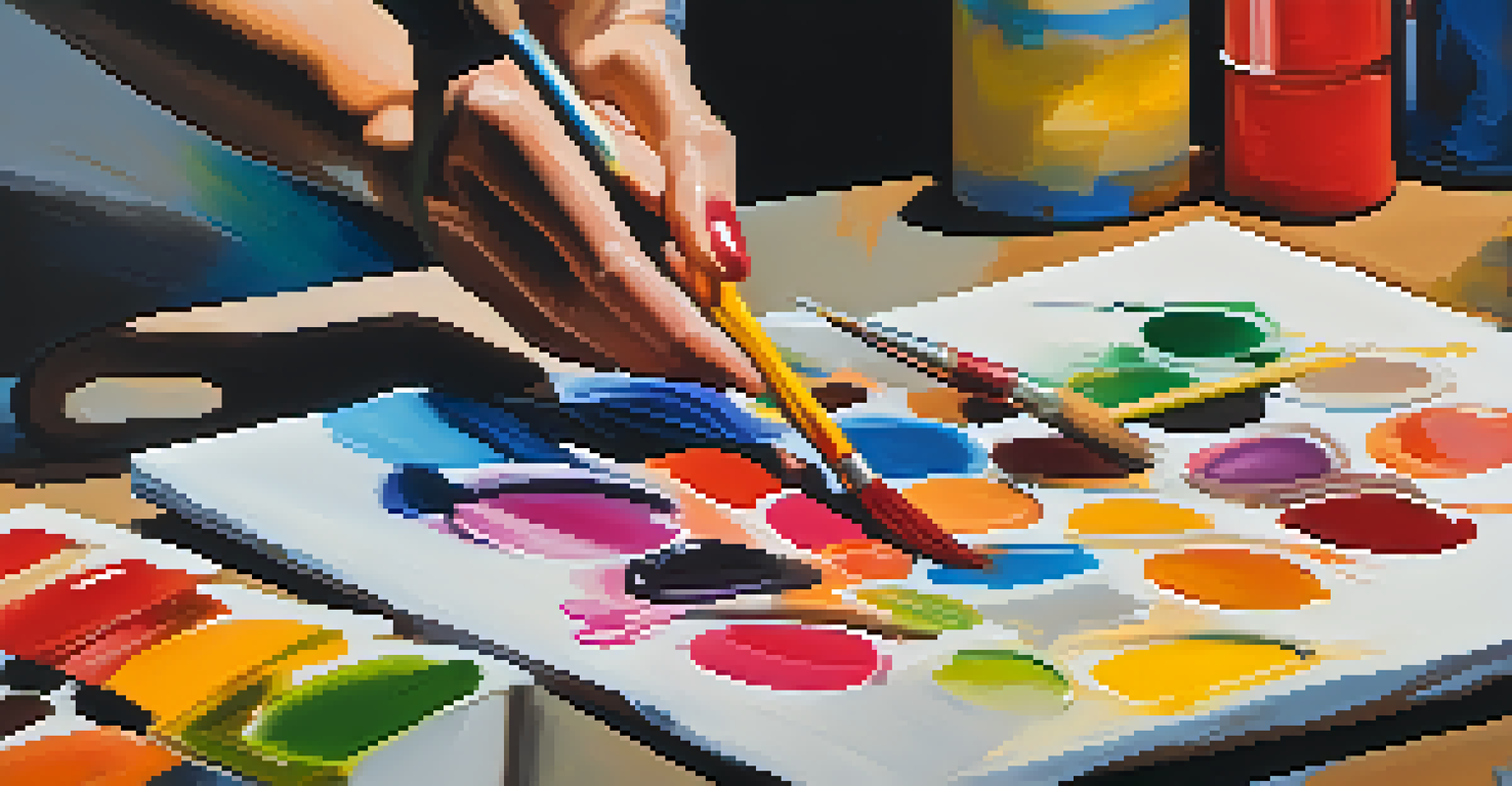The Intersection of Art and Psychology: Understanding Humanity

Art as a Reflection of Psychological States
Art has always served as a mirror to the human psyche, capturing emotions and thoughts that might be difficult to express in words. For example, a painting filled with dark colors may reflect the artist's struggle with depression, allowing viewers to connect with that feeling on a deeper level. This connection helps us understand not only the artist's emotional state but also our own experiences, making art a powerful tool for self-reflection.
Art is the most beautiful of all lies.
Moreover, artists often use their work to process trauma or complex emotions, creating a safe space for healing. An exhibition of expressive sculptures, for instance, can evoke feelings of vulnerability and resilience, drawing viewers into a shared human experience. Through this lens, art becomes a dialogue between the artist and the audience, facilitating empathy and understanding.
By engaging with art, we gain insight into the varied emotional landscapes of humanity. When we explore the psychological themes within artwork, we can better appreciate the myriad ways in which people cope with their internal struggles, ultimately enriching our understanding of ourselves and others.
The Psychological Impact of Art on Individuals
Art does not just reflect psychological states; it also has the power to influence them. Studies have shown that engaging with art can lead to improved mental health, reducing anxiety and enhancing overall well-being. Just think about how a beautiful landscape painting can instantly lift your spirits, providing a momentary escape from daily stressors.

Furthermore, art therapy has emerged as a recognized practice, harnessing the creative process to help individuals confront and process their emotions. In a therapy session, clients might paint or draw their feelings, allowing them to explore complex issues in a non-threatening way. This method not only fosters self-expression but also aids in emotional regulation.
Art Reflects and Influences Emotions
Art serves as both a mirror of our psychological states and a powerful tool for emotional healing and self-discovery.
The transformative effect of art highlights its importance in mental health discussions. By recognizing art as a therapeutic tool, we can encourage more individuals to explore their feelings creatively, thereby unlocking new pathways to healing and self-discovery.
Cultural Context: Art and Collective Psychology
Art is deeply influenced by the cultural context in which it is created, reflecting collective psychological themes and societal values. For example, during times of social upheaval, art often becomes a vehicle for protest, expressing the frustrations and aspirations of the community. Think of the powerful murals that emerged during the civil rights movement, which communicated a shared desire for justice and equality.
Every artist dips his brush in his own soul, and paints his own nature into his pictures.
This collective expression through art can foster a sense of identity and belonging among individuals in a society. When people see their experiences represented in art, it validates their feelings and fosters solidarity. It's a reminder that, despite our individual differences, we share common struggles and triumphs.
Understanding the interplay between culture and psychology through art can deepen our appreciation of both. By examining how collective experiences shape artistic expression, we can better comprehend the psychological landscape of a society and the unique narratives that arise from it.
The Influence of Emotion on Artistic Creation
Emotion plays a crucial role in the creative process, often serving as the primary motivation for artists. When an artist experiences intense feelings, whether joy, sadness, or anger, these emotions can pour onto the canvas or into their work. This raw expression often resonates with audiences, allowing them to connect with the piece on an emotional level.
Consider famous works like Edvard Munch's 'The Scream,' which powerfully encapsulates existential dread. The visceral emotion behind such artwork invites viewers to confront their own fears and anxieties, creating a shared emotional experience. This connection can be both cathartic and enlightening, revealing the depths of human emotion.
Cultural Context Shapes Artistic Expression
The cultural backdrop of art influences collective psychological themes, allowing for shared experiences and societal reflection.
The relationship between emotion and art underscores the importance of creativity in processing feelings. By channeling their emotions into art, creators not only heal themselves but also evoke empathy and understanding in those who engage with their work, creating a cycle of emotional exchange.
Art as a Means of Communication and Connection
Art transcends language barriers, serving as a universal means of communication that connects people across cultures and backgrounds. A striking photograph or a poignant piece of music can evoke emotions in anyone, regardless of their native language or personal experiences. This ability to communicate feelings and ideas makes art an essential tool for fostering global understanding.
Moreover, art often prompts conversations about important social issues, encouraging dialogue and reflection among diverse audiences. For instance, a powerful documentary film can spark discussions about mental health, identity, or social justice, bringing people together to share their perspectives. This connection through art helps bridge gaps between different communities and fosters a sense of unity.
Ultimately, the communicative power of art highlights our shared humanity. By engaging with various forms of artistic expression, we can cultivate empathy and understanding, reinforcing the idea that we are all interconnected.
The Role of Art in Personal Identity Formation
Art plays a significant role in shaping our personal identities, allowing individuals to explore and express who they are. Through creative outlets such as painting, writing, or music, people can reflect on their experiences, beliefs, and emotions. This process of self-discovery can lead to a stronger sense of self and increased confidence.
For many, art serves as a way to grapple with complex aspects of their identity, such as cultural background, gender, or sexuality. An artist may create work that reflects their journey of self-acceptance, resonating with others who share similar experiences. This shared exploration not only fosters community but also promotes understanding and acceptance of diverse identities.
Art Fosters Connection and Empathy
Through its universal language, art bridges gaps between individuals and communities, promoting understanding and dialogue on important issues.
As individuals engage with art, they contribute to a broader narrative about identity within society. By expressing their unique perspectives through creativity, they enrich the cultural tapestry, illustrating the beauty of human diversity and the importance of self-exploration.
Conclusion: The Unbreakable Bond Between Art and Psychology
The intersection of art and psychology offers profound insights into the human experience, revealing the complexities of our emotions, identities, and connections. As we explore this bond, we uncover how art not only reflects our psychological states but also influences them, fostering healing and understanding. It's a beautiful cycle that emphasizes the power of creativity in our lives.
By recognizing the role of art in personal and collective psychology, we can appreciate its importance in our everyday lives. Whether through creating, experiencing, or discussing art, we engage in a dialogue that enriches our understanding of ourselves and others. This shared journey ultimately strengthens our connections and builds empathy across diverse communities.

In a world where understanding humanity is more crucial than ever, embracing the intersection of art and psychology can illuminate the path toward deeper connections and a more compassionate society. As we continue to explore this relationship, we invite more individuals to engage with art as a means of understanding and expressing what it means to be human.